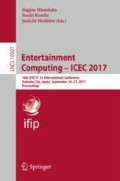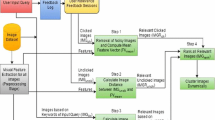Abstract
Nowadays, we often plan our travels by using tourism-related information abundantly available on the web. However, it is not simple to find useful information for your travel plans from enormous amount of information. This study, therefore, proposes a system that can make recommendations to you based on your preferences without you having to search information. Extracting the preferences of the users will be done simply by having images of their preferences selected by the users from the touristic images. The performance evaluation test on the system was also conducted.
You have full access to this open access chapter, Download conference paper PDF
Similar content being viewed by others
Keywords
1 Introduction
Along with the explosive diffusion of the Internet, enormous amout of touristic information has become available on the web, and we now often use the web information to plan our travels. However, such touristic information is provided randomly in various forms, sometiems created by municipalities, or in toursims information sites, blogs of individual persons as well as in reviews sites, and it is difficult for users to find useful information for their travel plans from the flood of touristic information.
In this article, we, therefore, propose a system that can recommend destinations of users’ preferences to them that only requires a simple operation. Supposing that the travel dates are already set, and users are trying to make plans and itineraries, this system would help and simplifies the travel planning. In order to realize the simple operation, the interface was set as users only need to select tourism-related photos of their preferences repeatedly with their intuition. Also, in order to examine the preference-analysis method of this system, an evaluation test on the recommendation performance was conducted.
2 System Architecture
2.1 System Overview
In this system, 16 image photos of different sightseeing destinations are displayed in the 4 × 4 boxes, and a user is to select 4 of them (Fig. 1). This process is to be repeated 10 times with different sets of image photos. This interface realizes the simplicity of extracting the users’ preferences. The photos displayed corresponds the node of the preference model mentioned in the next section, and as images are selected, the parameters of the node increase. Moreover, as the image photos are displayed in the manner that it covers the entire categories the system deals, it can be expected that the users would discover their new preferences they were not aware of themselves. The kinds of photos to be displayed will be mentioned in the section of the database.
2.2 User Preference Model
A preference model was created by defining user preferences in travels as:
-
Categories of sightseeing spots they would like to visit
-
Activities they would like to do at the destinations
The categories of sightseeing spots are set in a hierarchical structure such as “seeing-natural landscape-canyons”, and the preference model was set in the same hierarchical structure as well. And by input, parameters that indicate how much they value each item are added to the model. An example of the actual preference model is shown in Fig. 2.
When the evaluation value of a node N s \( \left| N \right| \), and the node group that belongs to the node is \( Nx\,\left( {x = 1, 2, \ldots , n} \right) \), it would be:
and, the evaluation value of the parent node directly affect the child node.
The characterization of the recommended tourist destinations would be determined by the categories and numbers of sightseeing spots of that destination. The number of the sightseeing spots is added with parameters to make it into the same model as the preference model, which would be normalized and expressed as the vector. The sightseeing spots and their categories, as well as the area they belong to were determined by referencing “Rakuten Travel Note” operated by Rakuten, Inc. As a result, the number of the sightseeing spots was 17,138, the number of the categories was 125 and the number of recommendation candidate areas was 209. The photos displayed in the input interface were those of the sightseeing spots obtained, and the categories of the photos correspond those of the sightseeing spots.
3 Evaluation Testing
3.1 Definition of Performance Index
They are known for their accuracy as an index for information search system, and often used for the evaluation index for recommendation systems [2]. These are defined as follows:
\( T_{i}^{x} \) is the group of items thde user preferred in recommendation candidates, and \( \left| {T_{i}^{x} } \right| \) is the number of the item, \( imL_{i}^{x} \) is the map of \( L_{i}^{x} \) mapping that indicates all the items in the map of \( L_{i}^{x} \) mapping that indicates all the items in the recommendation list. The accuracy is defined as the percentage of the preferred items \( b\,\in\,T_{i}^{x} \) in \( T_{i}^{x} \) against the size of the recommendation list.
3.2 Content of the Evaluation
Following test was conducted, using the above-mentioned index:
-
1.
To men and women from 22–26 years of age, all of the 209 areas that were candidates of recommendation areas were displayed randomly along with the sightseeing spots of their preferences, and had them answer how attractive they found them in Likert scale from 1 to 5 (1: “not attractive at all” – 5: “very attractive”).
-
2.
The areas they answered as 4 and 5 in 1 are defined as their preferred items.
-
3.
Using the system, the top three recommendation outcomes were created, and it was assessed how many places of their preferences are actually recommended.
3.3 Result of the Test
Table 1 is the average of each user’s knowledge and evaluation value of the 209 candidates for recommendation areas.
Table 2 shows the results of the accuracy calculations.
While among the candidates sites, the preferred sites were slightly less than half, the accuracy of the recommendation outcomes turned out to be slightly more than half. Although it can be considered effective in certain degree, in terms of the accuracy, there is plenty of room for improvement.
References
Rakuten, Inc., Rakuten Travel - Get the best deals on Japanese Hotels and Ryokans. http://travel.rakuten.com. Accessed 10 Dec 2016
Zhang, F.: Improving recommendation lists through neighbor diversification. In: IEEE International Conference on Intelligent Computing and Intelligent Systems, ICIS 2009, vol. 3, pp. 222–225 (2009)
Author information
Authors and Affiliations
Corresponding author
Editor information
Editors and Affiliations
Rights and permissions
Copyright information
© 2017 IFIP International Federation for Information Processing
About this paper
Cite this paper
Okuzono, M., Muta, M., Masuko, S., Kawata, H., Hoshino, J. (2017). Tourist Spot Recommendation System with Image Selection Interface. In: Munekata, N., Kunita, I., Hoshino, J. (eds) Entertainment Computing – ICEC 2017. ICEC 2017. Lecture Notes in Computer Science(), vol 10507. Springer, Cham. https://doi.org/10.1007/978-3-319-66715-7_53
Download citation
DOI: https://doi.org/10.1007/978-3-319-66715-7_53
Published:
Publisher Name: Springer, Cham
Print ISBN: 978-3-319-66714-0
Online ISBN: 978-3-319-66715-7
eBook Packages: Computer ScienceComputer Science (R0)







